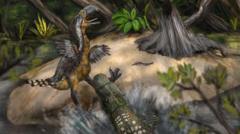Article:
Teeth marks found on a fossilized leg bone belonging to a large avian giant, known as the 'terror bird,' hint at a predatory encounter 13 million years ago in which the bird may have been killed by an even larger reptile. These colossal birds, towering above an average human, were equipped with formidable legs and beaks designed for tearing flesh. Palaeontologists in Colombia have matched the bite marks on this fossil to those of a crocodilian reptile, specifically a species of caiman. Using 3D digital scans of the marks, the researchers pieced together what seems to have been a "fatal confrontation" whereby the terror bird did not emerge victorious.
Published in the journal Biology Letters, the study examined the tooth mark's dimensions and shapes and compared them to collections of skulls and teeth from similar ancient predators stored in museums. The fossilized leg bone, originally unearthed in Colombia's Tatacoa Desert over 15 years ago, belonged to a bird that roamed the lush swamps during that era, reaching around 2.5 meters in height and exhibiting predatory traits.
However, the researchers have not definitively established whether this particular terror bird was killed directly during the attack or if it became a meal for the caiman post-mortem. "There are no signs of healing in the bite marks," stated lead researcher Andres Link of Universidad de Los Andes in Bogotá. “So if it wasn’t dead before the assault, it certainly was afterwards.”
The Tatacoa Desert is rich with fossils from the Middle Miocene epoch, a period characterized by its warm and swampy environment. Within this habitat, the sediments preserved the remains of many creatures, among them the terror birds. The leg bone's discovery can be credited to local fossil collector César Augusto Perdomo, who first found it and later collaborated with scientists to catalog it within his museum.
The analysis of the bite marks revealed their closest match to the extinct species, Purussaurus neivensis, a caiman that could grow up to five meters in length, which likely ambushed prey similarly to modern crocodiles. Dr. Link noted the strategic respiratory waiting at the water's edge for suitable targets.
This insight into the deadly interaction of two apex predators offers a rare glimpse into the dynamics of an ancient ecosystem, suggesting that these fearsome terror birds may have been more susceptible to predation than previously understood. “Every fragment adds to our comprehension of ancient life on Earth," remarked Dr. Link, emphasizing the scientific significance of even a single bone in enriching the historical narrative.
Teeth marks found on a fossilized leg bone belonging to a large avian giant, known as the 'terror bird,' hint at a predatory encounter 13 million years ago in which the bird may have been killed by an even larger reptile. These colossal birds, towering above an average human, were equipped with formidable legs and beaks designed for tearing flesh. Palaeontologists in Colombia have matched the bite marks on this fossil to those of a crocodilian reptile, specifically a species of caiman. Using 3D digital scans of the marks, the researchers pieced together what seems to have been a "fatal confrontation" whereby the terror bird did not emerge victorious.
Published in the journal Biology Letters, the study examined the tooth mark's dimensions and shapes and compared them to collections of skulls and teeth from similar ancient predators stored in museums. The fossilized leg bone, originally unearthed in Colombia's Tatacoa Desert over 15 years ago, belonged to a bird that roamed the lush swamps during that era, reaching around 2.5 meters in height and exhibiting predatory traits.
However, the researchers have not definitively established whether this particular terror bird was killed directly during the attack or if it became a meal for the caiman post-mortem. "There are no signs of healing in the bite marks," stated lead researcher Andres Link of Universidad de Los Andes in Bogotá. “So if it wasn’t dead before the assault, it certainly was afterwards.”
The Tatacoa Desert is rich with fossils from the Middle Miocene epoch, a period characterized by its warm and swampy environment. Within this habitat, the sediments preserved the remains of many creatures, among them the terror birds. The leg bone's discovery can be credited to local fossil collector César Augusto Perdomo, who first found it and later collaborated with scientists to catalog it within his museum.
The analysis of the bite marks revealed their closest match to the extinct species, Purussaurus neivensis, a caiman that could grow up to five meters in length, which likely ambushed prey similarly to modern crocodiles. Dr. Link noted the strategic respiratory waiting at the water's edge for suitable targets.
This insight into the deadly interaction of two apex predators offers a rare glimpse into the dynamics of an ancient ecosystem, suggesting that these fearsome terror birds may have been more susceptible to predation than previously understood. “Every fragment adds to our comprehension of ancient life on Earth," remarked Dr. Link, emphasizing the scientific significance of even a single bone in enriching the historical narrative.



















